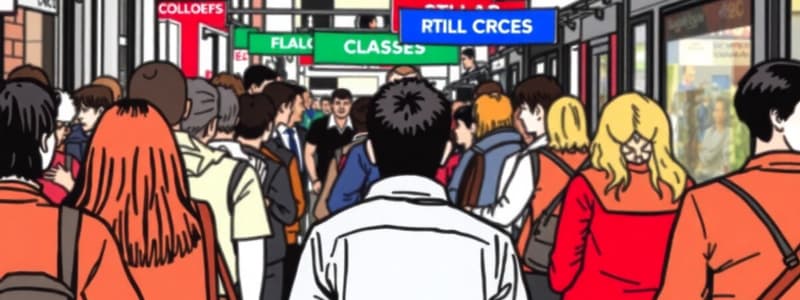Podcast
Questions and Answers
How does the UK's social stratification primarily manifest in urban, industrial societies?
How does the UK's social stratification primarily manifest in urban, industrial societies?
- Through economic inequality, including differences in income, wealth, and power. (correct)
- Through educational attainment and academic achievements.
- Through religious affiliations and moral values.
- Through political ideologies and party membership.
Which of the following provides the MOST accurate description of the middle class in the UK?
Which of the following provides the MOST accurate description of the middle class in the UK?
- Primarily characterized by long-term unemployment and homelessness.
- Composed exclusively of individuals with inherited wealth and aristocratic titles.
- The smallest group in the UK, consisting mainly of barristers and chief executives.
- The largest group in the UK, including white-collar professionals with moderate economic security. (correct)
Which of the following factors MOST significantly limits the ability of the working class to improve their pay and working conditions?
Which of the following factors MOST significantly limits the ability of the working class to improve their pay and working conditions?
- High levels of educational attainment.
- Lack of union representation. (correct)
- Guaranteed annual pay increases.
- Strong union representation.
What is the primary basis that the Office for National Statistics (ONS) uses to classify socioeconomic class?
What is the primary basis that the Office for National Statistics (ONS) uses to classify socioeconomic class?
How have economic shifts influenced the working class in the UK over the past 50 years?
How have economic shifts influenced the working class in the UK over the past 50 years?
What is a stereotype that members of the working class often face in UK society?
What is a stereotype that members of the working class often face in UK society?
Which group constitutes approximately 10% of the UK population and holds substantial influence in key societal positions?
Which group constitutes approximately 10% of the UK population and holds substantial influence in key societal positions?
In 2016, how did the income of the richest 10% of UK households compare to that of the poorest 10%?
In 2016, how did the income of the richest 10% of UK households compare to that of the poorest 10%?
Flashcards
Socioeconomic Class
Socioeconomic Class
Position in society based on job and financial status in industrialized countries.
Social Stratification
Social Stratification
Division of society into layers, often due to economic differences.
Lower Class
Lower Class
Long-term unemployed or homeless individuals.
Working Class
Working Class
Signup and view all the flashcards
Middle Class
Middle Class
Signup and view all the flashcards
Upper Class
Upper Class
Signup and view all the flashcards
Aristocrats
Aristocrats
Signup and view all the flashcards
ONS Classification
ONS Classification
Signup and view all the flashcards
Study Notes
Socioeconomic Class
- Socioeconomic class is based on a person's job and economic standing in society.
- In industrial societies like the UK, social stratification relies heavily on economic inequality, covering things like income, wealth, and power.
Class System in the UK
- The UK's class divisions are often split into five groups.
- Lower class includes the long-term unemployed and homeless.
- The working class includes low-skilled and semi-skilled workers, such as factory workers and laborers, who are often stereotyped.
- The middle class is the largest group, including white-collar professionals like teachers, journalists, and nurses, who have moderate economic security and better health compared to manual workers.
- The upper class features barristers and chief executives with high incomes.
- Aristocrats include the royal family and those with wealth or titles, such as lords and barons.
Class Divisions
- The top class (aristocrats and upper class) makes up around 10% of the population.
- This class controls a significant share of the nation's wealth and holds influential positions as senior politicians or directors of major companies.
- In 2016, the richest 10% of UK households had incomes 24 times greater than the poorest 10%.
- The middle class makes up over 50% of the population.
- It features diverse people with varying education and economic security, from upper-middle class professionals to lower-middle class office workers.
- The bottom class (working and lower class) has decreased over the past 50 years because of changes in the economy.
- It includes manual workers and low-skilled service workers, who often lack union representation, limiting their ability to improve pay and working conditions.
ONS Classification of Socioeconomic Class
- The Office for National Statistics (ONS) uses occupational categories to measure socioeconomic status.
- Higher managerial, administrative, and professional occupations: chief executive or judge.
- Lower managerial, administrative, and professional occupations: teacher or social worker.
- Intermediate occupations: clerical worker or nursery nurse.
- Small employers and own-account workers: shop owner or publican.
- Lower supervisory and technical occupations: plumber or mechanic.
- Semi-routine occupations: postal worker or security guard.
- Routine occupations: waitress or bar staff.
- Never worked or long-term unemployed.
Studying That Suits You
Use AI to generate personalized quizzes and flashcards to suit your learning preferences.




